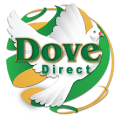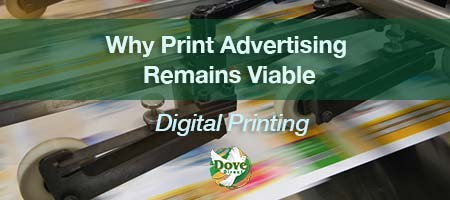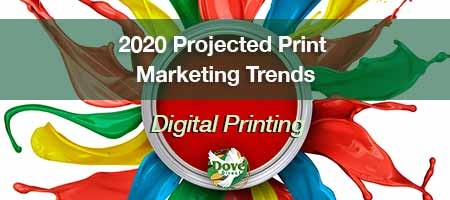Why Print Advertising Remains Viable
Welcome to the Dove Direct Print and Marketing Blog. Today's post, "Why Print Advertising Remains Viable," revisits print's effectiveness and why print advertising continues to be a valued medium for advertisers. For years, marketing gurus and brand experts have decried various assertions about the state of print, from the likes of, "print is dead" to "print no longer matters," and similar, more sinister statements.
Let's review what's going on in the world of print advertising. It's no secret that newspaper and magazine subscribers have been in decline. However, although circulation trends are down, these magazines can now assert that the current readership is more focused, and to that extent, the exact audience to receive a marketers' message.
The American Marketing Association states, "Print circulations are down, but in many cases, that means that publications' readership has been culled to only the most engaged, which is a desirable trait, from an advertising standpoint." Therefore, it is of great importance to also realize that the effectiveness of print ads is not in decline; instead, they are more focused and critical for a few categories.
Print is More Trustworthy
Over the past three years, print collateral has risen to be the most trustworthy type of advertisement. MarketingSherpa surveyed 1,200 Americans in 2016 and discovered that consumers trust print ads over any other kind of advertising. The following are the results gleaned from one of the survey's questions:
In general, which type of advertising channels do you trust more when you want to make a purchase decision?
- Print ads (newspapers, magazines) = 82%
- TV ads = 80%
- Ads/catalogs I receive in the mail = 76%
- Radio Ads = 71%
- Ads in outdoor and public places ( like billboards, transit ads, posters, etc.) = 69%
- Search engine ads (Google, Yahoo, Bing, etc.) = 61%
- Video ads that appear prior to an online video = 47%
- Sponsored posts on blogs that I read = 43%
- Ads embedded in social media (Facebook, Instagram, etc.) = 43%
- Online banner ads = 39%
- Mobile Phone ads = 39%
- Ads in podcasts = 37%
- Online pop-ups = 25%
In this MarketingSherpa survey, folks sorted advertising channels into "ads I trust," and "ads I don't trust." These numbers have been in the media comparison sphere since 2016 and continue to hold steady in 2019.
2018 DMA Response Rate Report
The DMA Response Rate Report includes direct mail piece size, the industries that top the charts for using direct mail, and the most popular methods advertisers use to track the results.
It may shock you to learn that letter-sized direct mail outperformed all other channels when it came to lead generation. Letter-sized direct mail delivers a whopping 15.1% response rate in lead generation. Simply astounding! Here are the industries that are leading the pack with the usage of direct mail: Hospitality and Travel at 80%, followed by Nonprofit at 75%, then Media or Publishing at 71%. Next were Financial Services/Banks. Credit at 67%, Healthcare coming in at 63%, and surprisingly, just 50% of the insurance sector confirm to using direct mail.
Brand Recall
The Internet is full of distractions. Any online destination is chock full of links, ads, calls-to-action, and a host of other attention grabbers. Conversely, one could argue that folks who are reading newspapers and magazines have distractions; however, there are far fewer, and reading print requires a physical interaction with the printed content that no other medium provides.
Media Space Solutions adds that even though "digital content is scanned quickly, paper-based reading is slower and more deliberate, resulting in greater rates of comprehension and recall. For advertisers, this means that traditional print media ads are more likely to make a lasting impression and, thus, lead to more sales."
Therefore, it should be of no surprise that neuroscientists have discovered that 70% are more likely to recall your brand after seeing it in print versus a digital version.
Print Outlasts Digital
Have you ever thought of deleting your Facebook account because of the ad bombardment arriving in your timeline nearly every time you access your account? Or, what if every time a person searched, they kept seeing your ad on Google, and decided to quit using Google?
When you visit your doctor or automotive service department, you'll notice newspapers and magazines on the counters or racks in public spaces. It should come as no surprise that the shelf-life of those publications is extended for weeks and passed-along to various readers visiting the establishment. This type of viewing/sharing increases the reach of the publication before it is removed or recycled.
The American Marketing Association recently stated, "Print ads are worth it in the end because of print's longer shelf life and higher potential for reverberations beyond the initial reader."
Print Engages Audience Interests
Folks subscribe to various newspapers and magazines based on their interests. Those specific interests translate into captive audiences who are looking for that particular content. In addition, any ads in the publication are also of interest as they tend to align with the overall content of the magazine or newspaper. Therefore, the print publication and the ads contained therein both add value for the reader.
Folks tend to read magazines to improve their professional status, learn more about a particular interest, or dive into their passions. Interestingly enough, the ads are viewed as part of the reading experience and not an interruption of the content!
Britt Fero, the founder of PB&, states it this way. "People are in different mental spaces when they choose to engage with a printed magazine versus digital content. What does the reader want to get out of those five minutes that he spends with that particular title? This is really where, in marketing, you can add value to a medium because the reader is looking for specific content versus just talking about your brand."
Digital advertising is great for accumulating data and for delivering quick insertions into the mix. However, for achieving market penetration, print needs to be part of your strategy. By physically placing your branded content into the hands of people, a connection occurs, and that creates a lasting impression, which goes to the heart of brand recall. All successful advertising and marketing exploits share a commonality in that the level of engagement, response rates, and brand recall is of the highest order.
The Net-Net
Regardless of the marketing strategy, it's called a media mix for a reason. No one medium can deliver everything. With various niche groups splintering even further, the media landscape to reach them is more complicated. Brand recall, trustworthiness, and emotive responses are the hallmarks of print collateral. We contend that by adding print to the mix, you will achieve significantly better results, develop longer-lasting impressions, and in all likelihood, will even enjoy a lift. Thanks for reading "Why Print Advertising Remains Viable."
Let's have a conversation about integrated business solutions and how they can help grow your business, change behavior, and improve the customer experience. Please join us at our next Open House. You can learn about our solutions including direct mail strategies, printing, print software, transactional documents, variable digital printing, brand equity and unified marketing collateral. We invite you to join us for an hour or two, November 21, from 10:30am to 3:30pm. You can also tour our 58k+ Sq. Ft. facility and experience our vast array of state-of-the-art print, mail, and sorting infrastructure.
Let us show you how to improve your document processes to optimize your workflow, reduce your costs, and maximize your organization's printing, letter shop, and mailing capabilities. Dove Direct does have an official USPS certified bureau located within our offices that will save you time and money. And, if you bring us your files, we will create a demo file for you. For more information, call Carla Eubanks at 404-629-0122 or email Carla at This email address is being protected from spambots. You need JavaScript enabled to view it..
Dove Direct, your Atlanta based print and mail solutions provider, offers organizations end-to-end data, printing, and mailing solutions: Data Management, Variable Digital Printing, LetterShop and Fulfillment, Fully Automated MLOCR Presort Bureau, Marketing and Production Management Support and Secure Data Life Cycle Management.
If you don't want to wait for the Open House, you can reach Dove Direct today by calling 404-629-0122 or use the Contact Form for Dove Direct.





